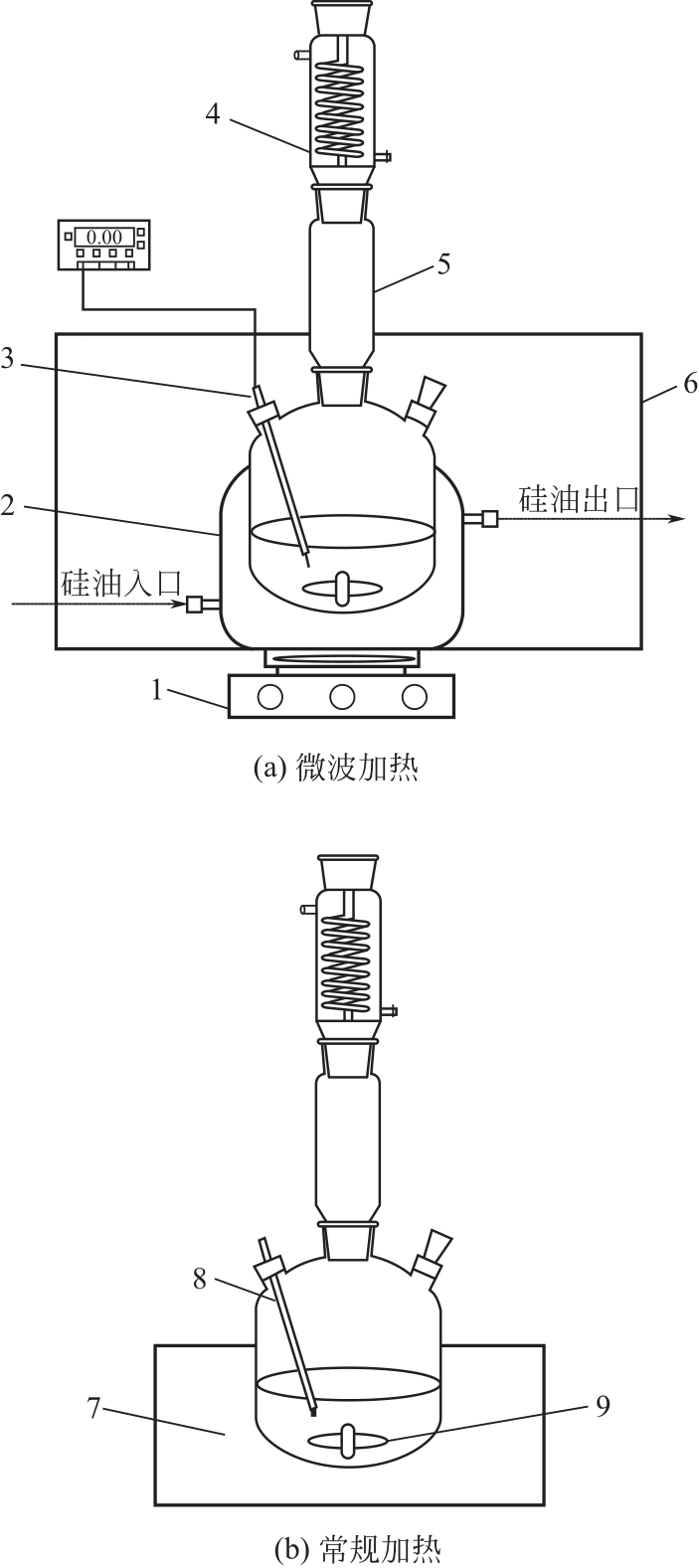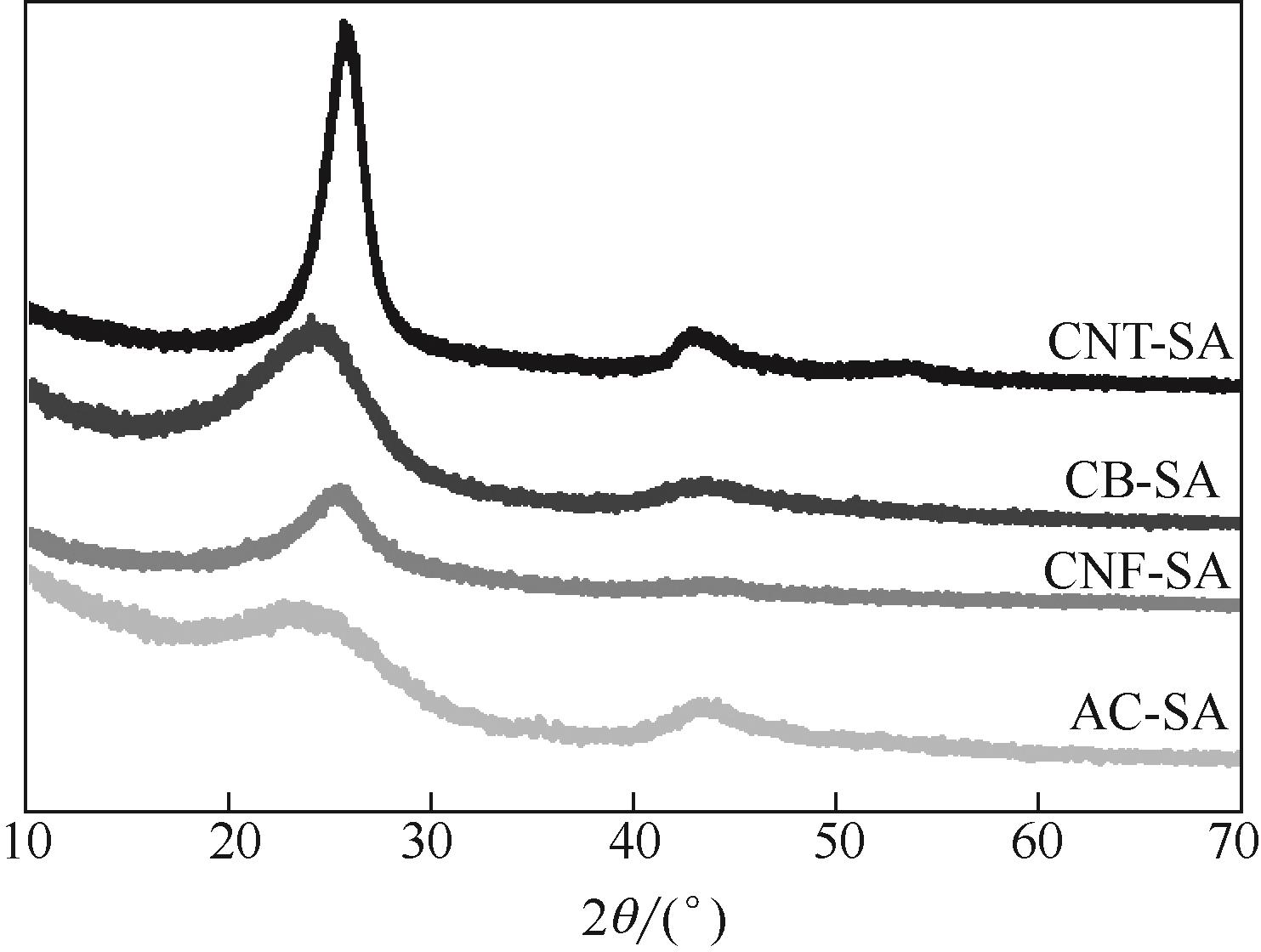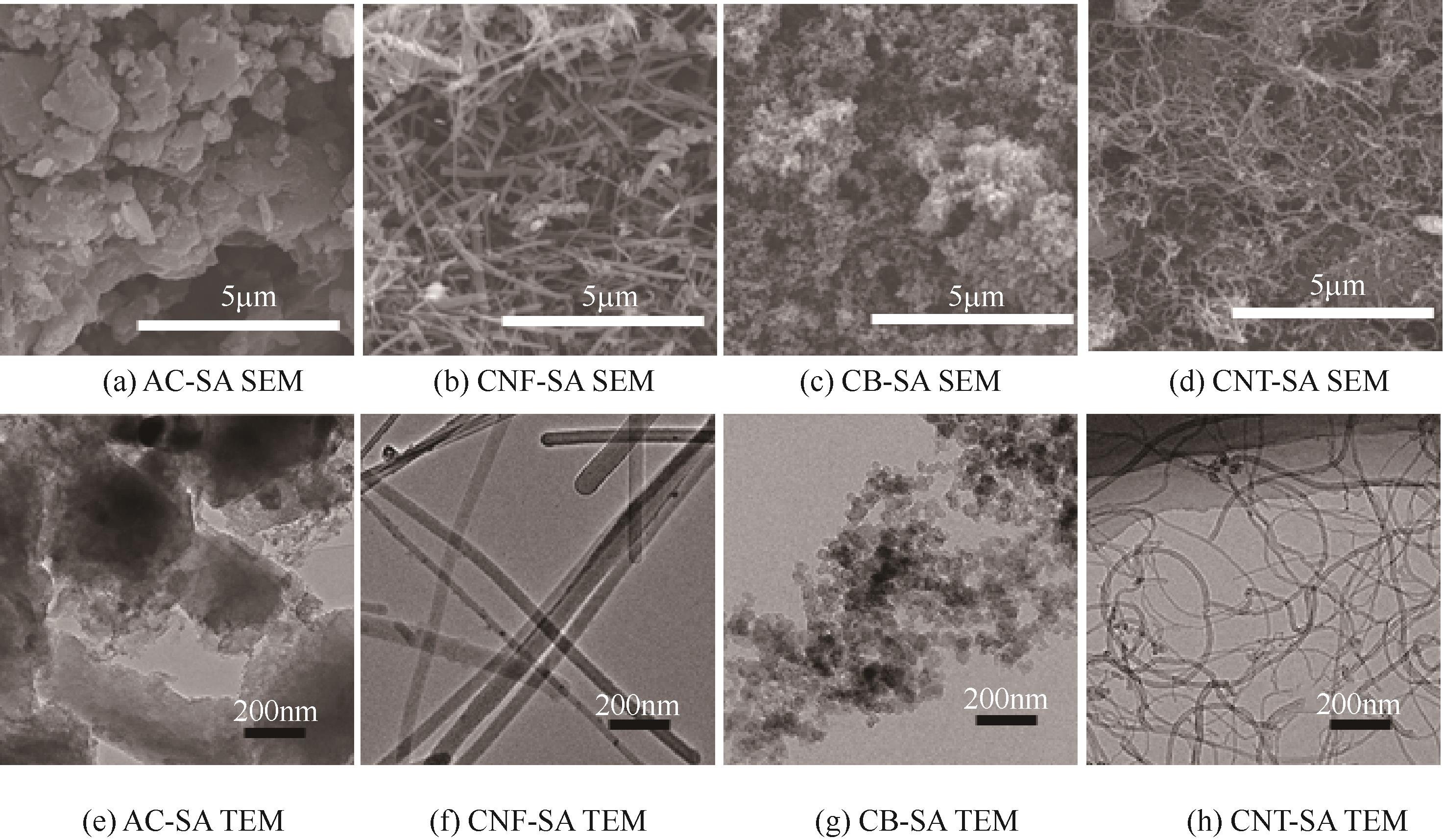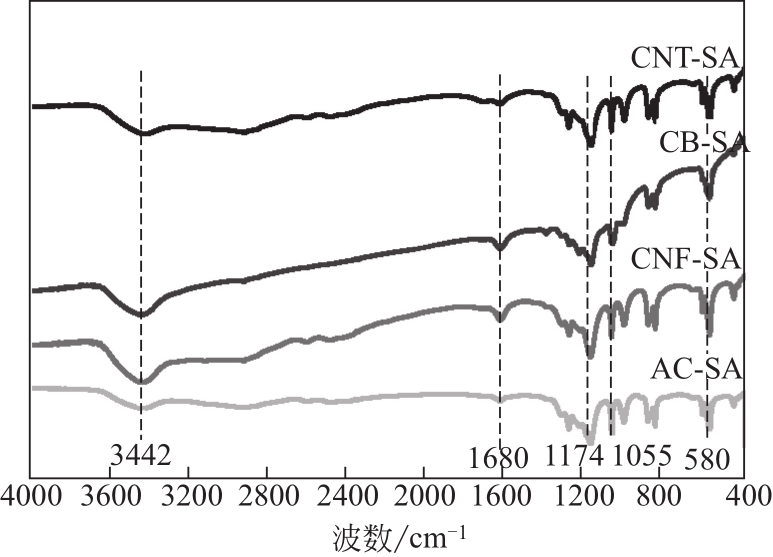化工进展 ›› 2022, Vol. 41 ›› Issue (2): 637-647.DOI: 10.16085/j.issn.1000-6613.2021-0671
微波与碳基催化剂协同促进果糖制5-羟甲基糠醛
吕孝琦1( ), 李洪1, 赵振宇1, 李鑫钢1, 高鑫1(
), 李洪1, 赵振宇1, 李鑫钢1, 高鑫1( ), 范晓雷2(
), 范晓雷2( )
)
- 1.天津大学化工学院,精馏技术国家工程研究中心,天津 300350
2.曼彻斯特大学工程学院,化学工程与;分析科学系,英国 曼彻斯特 M13 9PL
-
收稿日期:2021-03-31修回日期:2021-07-19出版日期:2022-02-05发布日期:2022-02-23 -
通讯作者:高鑫,范晓雷 -
作者简介:吕孝琦(1996—),女,硕士研究生,研究方向为微波强化反应过程。E-mail:lxq77@tju.edu.cn 。 -
基金资助:国家自然科学基金面上项目(21878219);欧盟“地平线2020”研究与创新基金(872102)
Microwave-assisted carbon-based catalysts for fructose dehydration to 5-hydroxymethylfurfural
LYU Xiaoqi1( ), LI Hong1, ZHAO Zhenyu1, LI Xingang1, GAO Xin1(
), LI Hong1, ZHAO Zhenyu1, LI Xingang1, GAO Xin1( ), FAN Xiaolei2(
), FAN Xiaolei2( )
)
- 1.National Engineering Research Center of Distillation Technology, School of Chemical Engineering and Technology, Tianjin University, Tianjin 300350, China
2.Department of Chemical Engineering and Analytical Science, School of Engineering, University of Manchester, Manchester M13 9PL, United Kingdom
-
Received:2021-03-31Revised:2021-07-19Online:2022-02-05Published:2022-02-23 -
Contact:GAO Xin,FAN Xiaolei
摘要:
生物质转化为高附加值的化学品是替代石化产品的有效途径,微波与催化剂的协同作用有助于提升糖类的转化效率。碳材料具有良好的化学稳定性和介电性,是微波反应过程中理想的催化剂载体和吸波剂。为了探究碳基催化剂对微波场的响应能力,本文以4种碳材料为载体应用于果糖转化过程,包括碳纳米管(CNT)、碳纳米纤维(CNF)、炭黑(CB)和活性炭(AC)。以果糖转化率和5-羟甲基糠醛(5-HMF)收率为评价指标,对比不同催化剂在常规和微波加热条件下的催化性能,探究微波与不同载体的耦合作用对反应的强化效果。在微波场中测量不同碳材料悬浮液的温度曲线,评价碳基催化剂在微波场中的加热能力。通过表征样品结构和介电参数,解释载体与微波间耦合作用差异的原因。结果表明,碳基催化剂的微波诱导热效应可以有效提升反应转化率和收率,拥有高损耗角正切值和电导率的催化剂把微波能转化为热量的能力较强,更有助于将微波能量传递至反应表面。高比表面积、高长径比、低密度和高石墨化度的碳基催化剂也有利于产生微波热效应。另外,由于显著的微波热效应,碳纳米管基催化剂CNT-SA在4类催化剂中催化性能最优,以110℃微波辐射10min,5-HMF收率可达96.30%,且催化剂具有良好的循环使用性能。
中图分类号:
引用本文
吕孝琦, 李洪, 赵振宇, 李鑫钢, 高鑫, 范晓雷. 微波与碳基催化剂协同促进果糖制5-羟甲基糠醛[J]. 化工进展, 2022, 41(2): 637-647.
LYU Xiaoqi, LI Hong, ZHAO Zhenyu, LI Xingang, GAO Xin, FAN Xiaolei. Microwave-assisted carbon-based catalysts for fructose dehydration to 5-hydroxymethylfurfural[J]. Chemical Industry and Engineering Progress, 2022, 41(2): 637-647.
| 样品 | ε' | ε'' | tanδ | σ/μS·cm-1 |
|---|---|---|---|---|
| DMSO | 44.60 | 11.05 | 0.2478 | 0.17 |
| AC-SA悬浮液 | 44.78 | 11.18 | 0.2497 | 1.64 |
| CNF-SA悬浮液 | 44.84 | 11.24 | 0.2507 | 2.07 |
| CB-SA悬浮液 | 45.09 | 11.41 | 0.2531 | 2.33 |
| CNT-SA悬浮液 | 45.61 | 11.82 | 0.2591 | 4.35 |
表1 4种碳基催化剂的介电性能和电导率
| 样品 | ε' | ε'' | tanδ | σ/μS·cm-1 |
|---|---|---|---|---|
| DMSO | 44.60 | 11.05 | 0.2478 | 0.17 |
| AC-SA悬浮液 | 44.78 | 11.18 | 0.2497 | 1.64 |
| CNF-SA悬浮液 | 44.84 | 11.24 | 0.2507 | 2.07 |
| CB-SA悬浮液 | 45.09 | 11.41 | 0.2531 | 2.33 |
| CNT-SA悬浮液 | 45.61 | 11.82 | 0.2591 | 4.35 |
| 样品名称 | 石墨化度/% | 比表面积/m2·g-1 | 孔容/cm3·g-1 | 密度/g·cm-3 |
|---|---|---|---|---|
| AC-SA | 31.32 | 1093.37 | 0.59 | 0.45 |
| CNF-SA | 66.24 | 37.52 | 0.17 | 2.10 |
| CB-SA | 16.38 | 103.37 | 0.43 | 0.28 |
| CNT-SA | 73.58 | 190.80 | 0.84 | 0.13 |
表2 4种碳基催化剂的比表面及结构参数
| 样品名称 | 石墨化度/% | 比表面积/m2·g-1 | 孔容/cm3·g-1 | 密度/g·cm-3 |
|---|---|---|---|---|
| AC-SA | 31.32 | 1093.37 | 0.59 | 0.45 |
| CNF-SA | 66.24 | 37.52 | 0.17 | 2.10 |
| CB-SA | 16.38 | 103.37 | 0.43 | 0.28 |
| CNT-SA | 73.58 | 190.80 | 0.84 | 0.13 |
| 样品 | 总酸浓度 /mmol·g-1 | 磺酸基团浓度 /mmol·g-1 | 羧酸基团和酚羟基浓度 /mmol·g-1 |
|---|---|---|---|
| AC-SA | 3.28 | 0.51 | 2.77 |
| CNF-SA | 4.14 | 0.62 | 3.52 |
| CB-SA | 3.86 | 0.56 | 3.30 |
| CNT-SA | 3.92 | 0.60 | 3.32 |
表3 4种碳基催化剂的酸度分布
| 样品 | 总酸浓度 /mmol·g-1 | 磺酸基团浓度 /mmol·g-1 | 羧酸基团和酚羟基浓度 /mmol·g-1 |
|---|---|---|---|
| AC-SA | 3.28 | 0.51 | 2.77 |
| CNF-SA | 4.14 | 0.62 | 3.52 |
| CB-SA | 3.86 | 0.56 | 3.30 |
| CNT-SA | 3.92 | 0.60 | 3.32 |
| 样品 | 升温速率/℃·min-1 | 稳定温度/℃ | 达到稳定时间/min |
|---|---|---|---|
| DMSO纯溶剂 | 25.41 | 109.52 | 3.49 |
| AC-SA悬浮液 | 43.95 | 110.55 | 2.04 |
| CNF-SA悬浮液 | 51.46 | 110.70 | 1.76 |
| CB-SA悬浮液 | 56.54 | 112.06 | 1.62 |
| CNT-SA悬浮液 | 68.05 | 112.30 | 1.35 |
表4 4种碳基催化剂的微波加热参数
| 样品 | 升温速率/℃·min-1 | 稳定温度/℃ | 达到稳定时间/min |
|---|---|---|---|
| DMSO纯溶剂 | 25.41 | 109.52 | 3.49 |
| AC-SA悬浮液 | 43.95 | 110.55 | 2.04 |
| CNF-SA悬浮液 | 51.46 | 110.70 | 1.76 |
| CB-SA悬浮液 | 56.54 | 112.06 | 1.62 |
| CNT-SA悬浮液 | 68.05 | 112.30 | 1.35 |
| 1 | JING Y X, GUO Y, XIA Q N, et al. Catalytic production of value-added chemicals and liquid fuels from lignocellulosic biomass[J]. Chem, 2019, 5(10): 2520-2546. |
| 2 | WANG J J, XU W J, REN J W, et al. Efficient catalytic conversion of fructose into hydroxymethylfurfural by a novel carbon-based solid acid[J]. Green Chemistry, 2011, 13(10): 2678-2681. |
| 3 | HUBER G W, CHHEDA J N, BARRETT C J, et al. Production of liquid alkanes by aqueous-phase processing of biomass-derived carbohydrates[J]. Science, 2005, 308(5727): 1446-1450. |
| 4 | WEI Z J, LOU J T, LI Z B, et al. One-pot production of 2, 5-dimethylfuran from fructose over Ru/C and a Lewis–Brønsted acid mixture in N,N-dimethylformamide[J]. Catalysis Science & Technology, 2016, 6(16): 6217-6225. |
| 5 | TOFTGAARD PEDERSEN A, RINGBORG R, GROTKJÆR T, et al. Synthesis of 5-hydroxymethylfurfural (HMF) by acid catalyzed dehydration of glucose-fructose mixtures[J]. Chemical Engineering Journal, 2015, 273: 455-464. |
| 6 | MARULLO S, RIZZO C, MELI A, et al. Ionic liquid binary mixtures, zeolites, and ultrasound irradiation: a combination to promote carbohydrate conversion into 5-hydroxymethylfurfural[J]. ACS Sustainable Chemistry & Engineering, 2019, 7(6): 5818-5826. |
| 7 | BESSON M, GALLEZOT P, PINEL C. Conversion of biomass into chemicals over metal catalysts[J]. Chemical Reviews, 2014, 114(3): 1827-1870. |
| 8 | TEMPELMAN C, JACOBS U, HUT T, et al. Sn exchanged acidic ion exchange resin for the stable and continuous production of 5-HMF from glucose at low temperature[J]. Applied Catalysis A: General, 2019, 588: 117267. |
| 9 | SHAHANGI F, NAJAFI CHERMAHINI A, SARAJI M. Dehydration of fructose and glucose to 5-hydroxymethylfurfural over Al-KCC-1 silica[J]. Journal of Energy Chemistry, 2018, 27(3): 769-780. |
| 10 | LAM E, LUONG J H T. Carbon materials as catalyst supports and catalysts in the transformation of biomass to fuels and chemicals[J]. ACS Catalysis, 2014, 4(10): 3393-3410. |
| 11 | CHHABRA T, BAHUGUNA A, DHANKHAR S S, et al. Sulfonated graphitic carbon nitride as a highly selective and efficient heterogeneous catalyst for the conversion of biomass-derived saccharides to 5-hydroxymethylfurfural in green solvents[J]. Green Chemistry, 2019, 21(21): 6012-6026. |
| 12 | YU X, CHU Y Y, ZHANG L, et al. Adjacent acid sites cooperatively catalyze fructose to 5-hydroxymethylfurfural in a new, facile pathway[J]. Journal of Energy Chemistry, 2020, 47: 112-117. |
| 13 | CRISCI A J, TUCKER M H, LEE M Y, et al. Acid-functionalized SBA-15-type silica catalysts for carbohydrate dehydration[J]. ACS Catalysis, 2011, 1(7): 719-728. |
| 14 | CAO Z, FAN Z X, CHEN Y, et al. Efficient preparation of 5-hydroxymethylfurfural from cellulose in a biphasic system over hafnyl phosphates[J]. Applied Catalysis B: Environmental, 2019, 244: 170-177. |
| 15 | DE BRUYN M, FAN J, BUDARIN V L, et al. A new perspective in bio-refining: levoglucosenone and cleaner lignin from waste biorefinery hydrolysis lignin by selective conversion of residual saccharides[J]. Energy & Environmental Science, 2016, 9(8): 2571-2574. |
| 16 | 赵振宇, 李洪, 李鑫钢, 等. 基于介电性质差异的微波诱导强化蒸馏分离[J]. 化工进展, 2020, 39(6): 2275-2283. |
| ZHAO Zhenyu, LI Hong, LI Xingang, et al. Microwave-induced enhancement of distillation separation based on dielectric properties difference[J]. Chemical Industry and Engineering Progress, 2020, 39(6): 2275-2283. | |
| 17 | WANG Q F, HAO J Q, ZHAO Z B. Microwave-assisted conversion of fructose to 5-hydroxymethylfurfural using sulfonated porous carbon derived from biomass[J]. Australian Journal of Chemistry, 2018, 71(1): 24. |
| 18 | JIA X C, YU I K M, TSANG D C W, et al. Functionalized zeolite-solvent catalytic systems for microwave-assisted dehydration of fructose to 5-hydroxymethylfurfural[J]. Microporous and Mesoporous Materials, 2019, 284: 43-52. |
| 19 | QI X H, WATANABE M, AIDA T M, et al. Selective conversion of D-fructose to 5-hydroxymethylfurfural by ion-exchange resin in acetone/dimethyl sulfoxide solvent mixtures[J]. Industrial & Engineering Chemistry Research, 2008, 47(23): 9234-9239. |
| 20 | UMRIGAR V R, CHAKRABORTY M, PARIKH P. Catalytic activity of zeolite Hβ for the preparation of fuels’ additives: its product distribution and scale up calculation for the biofuel formation in a microwave assisted batch reactor[J]. Journal of Environmental Chemical Engineering, 2018, 6(6): 6816-6827. |
| 21 | JI T, TU R, MU L W, et al. Structurally tuning microwave absorption of core/shell structured CNT/polyaniline catalysts for energy efficient saccharide-HMF conversion[J]. Applied Catalysis B: Environmental, 2018, 220: 581-588. |
| 22 | YU I K M, XIONG X N, TSANG D C W, et al. Graphite oxide- and graphene oxide-supported catalysts for microwave-assisted glucose isomerisation in water[J]. Green Chemistry, 2019, 21(16): 4341-4353. |
| 23 | DUTTA S, DE S, PATRA A K, et al. Microwave assisted rapid conversion of carbohydrates into 5-hydroxymethylfurfural catalyzed by mesoporous TiO2 nanoparticles[J]. Applied Catalysis A: General, 2011, 409/410: 133-139. |
| 24 | WANG J, QU T, LIANG M S, et al. Microwave assisted rapid conversion of fructose into 5-HMF over solid acid catalysts[J]. RSC Advances, 2015, 5(128): 106053-106060. |
| 25 | VASUDEVAN S V, KONG X H, CAO M J, et al. Microwave-assisted liquefaction of carbohydrates for 5-hydroxymethylfurfural using tungstophosphoric acid encapsulated dendritic fibrous mesoporous silica as a catalyst[J]. Science of the Total Environment, 2021, 760: 143379. |
| 26 | SANTOS E J, KAXIRAS E. Electric-field dependence of the effective dielectric constant in graphene[J]. Nano Letters, 2013, 13(3): 898-902. |
| 27 | 翟金鹏, 李鑫钢, 李洪, 等. 微波诱导热解废旧润滑油的研究[J]. 现代化工, 2020, 40(1): 77-80, 85. |
| ZHAI Jinpeng, LI Xingang, LI Hong, et al. Microwave induced pyrolysis of waste lubricant oil[J]. Modern Chemical Industry, 2020, 40(1): 77-80, 85. | |
| 28 | XU H, YIN X, ZHU M, et al. Carbon hollow microspheres with a designable mesoporous shell for high-performance electromagnetic wave absorption[J]. ACS Applied Materials & Interfaces, 2017, 9(7): 6332-6341. |
| 29 | CONTESCU A, CONTESCU C, PUTYERA K, et al. Surface acidity of carbons characterized by their continuous pK distribution and Boehm titration[J]. Carbon, 1997, 35(1): 83-94. |
| 30 | ZHANG X H, TAN C, MA Y H, et al. BaTiO3@carbon/silicon carbide/poly(vinylidene fluoride-hexafluoropropylene) three-component nanocomposites with high dielectric constant and high thermal conductivity[J]. Composites Science and Technology, 2018, 162: 180-187. |
| 31 | LI X, TUO Y X, LI P, et al. Effects of carbon support on microwave-assisted catalytic dehydrogenation of decalin[J]. Carbon, 2014, 67: 775-783. |
| 32 | YANG J F, ZHANG H Y, AO Z F, et al. Hydrothermal carbon enriched with sulfonic and carboxyl groups as an efficient solid acid catalyst for butanolysis of furfuryl alcohol[J]. Catalysis Communications, 2019, 123: 109-113. |
| 33 | LIU H H, GU S L, CAO H, et al. A dense packing structure constructed by flake and spherical graphite: simultaneously enhanced in-plane and through-plane thermal conductivity of polypropylene/graphite composites[J]. Composites Communications, 2020, 19: 25-29. |
| 34 | WU K H, TING T H, WANG G P, et al. Effect of carbon black content on electrical and microwave absorbing properties of polyaniline/carbon black nanocomposites[J]. Polymer Degradation and Stability, 2008, 93(2): 483-488. |
| 35 | BALBERG I. A comprehensive picture of the electrical phenomena in carbon black-polymer composites[J]. Carbon, 2002, 40(2): 139-143. |
| 36 | QI W, HE C, WANG Q, et al. Carbon-based solid acid pretreatment in corncob saccharification: specific xylose production and efficient enzymatic hydrolysis[J]. ACS Sustainable Chemistry & Engineering, 2018, 6(3): 3640-3648. |
| 37 | HU L, LI Z, WU Z, et al. Catalytic hydrolysis of microcrystalline and rice straw-derived cellulose over a chlorine-doped magnetic carbonaceous solid acid[J]. Industrial Crops and Products, 2016, 84: 408-417. |
| 38 | DURKA T, GERVEN T VAN, STANKIEWICZ A. Microwaves in heterogeneous gas-phase catalysis: experimental and numerical approaches[J]. Chemical Engineering & Technology, 2009, 32(9): 1301-1312. |
| 39 | QI X H, WATANABE M, AIDA T M, et al. Catalytic dehydration of fructose into 5-hydroxymethylfurfural by ion-exchange resin in mixed-aqueous system by microwave heating[J]. Green Chemistry, 2008, 10(7): 799. |
| 40 | MARULLO S, RIZZO C, D’ANNA F. Activity of a heterogeneous catalyst in deep eutectic solvents: the case of carbohydrate conversion into 5-hydroxymethylfurfural[J]. ACS Sustainable Chemistry & Engineering, 2019, 7(15): 13359-13368. |
| 41 | KANG S M, FU J X, ZHANG G. From lignocellulosic biomass to levulinic acid: a review on acid-catalyzed hydrolysis[J]. Renewable and Sustainable Energy Reviews, 2018, 94: 340-362. |
| 42 | WHITAKER M R, PARULKAR A, RANADIVE P, et al. Examining acid formation during the selective dehydration of fructose to 5-hydroxymethylfurfural in dimethyl sulfoxide and water[J]. ChemSusChem, 2019, 12(10): 2211-2219. |
| 43 | FRAILE J M, GARCÍA-BORDEJÉ E, PIRES E, et al. Catalytic performance and deactivation of sulfonated hydrothermal carbon in the esterification of fatty acids: comparison with sulfonic solids of different nature[J]. Journal of Catalysis, 2015, 324: 107-118. |
| [1] | 张明焱, 刘燕, 张雪婷, 刘亚科, 李从举, 张秀玲. 非贵金属双功能催化剂在锌空气电池研究进展[J]. 化工进展, 2023, 42(S1): 276-286. |
| [2] | 时永兴, 林刚, 孙晓航, 蒋韦庚, 乔大伟, 颜彬航. 二氧化碳加氢制甲醇过程中铜基催化剂活性位点研究进展[J]. 化工进展, 2023, 42(S1): 287-298. |
| [3] | 谢璐垚, 陈崧哲, 王来军, 张平. 用于SO2去极化电解制氢的铂基催化剂[J]. 化工进展, 2023, 42(S1): 299-309. |
| [4] | 杨霞珍, 彭伊凡, 刘化章, 霍超. 熔铁催化剂活性相的调控及其费托反应性能[J]. 化工进展, 2023, 42(S1): 310-318. |
| [5] | 郑谦, 官修帅, 靳山彪, 张长明, 张小超. 铈锆固溶体Ce0.25Zr0.75O2光热协同催化CO2与甲醇合成DMC[J]. 化工进展, 2023, 42(S1): 319-327. |
| [6] | 王正坤, 黎四芳. 双子表面活性剂癸炔二醇的绿色合成[J]. 化工进展, 2023, 42(S1): 400-410. |
| [7] | 高雨飞, 鲁金凤. 非均相催化臭氧氧化作用机理研究进展[J]. 化工进展, 2023, 42(S1): 430-438. |
| [8] | 王乐乐, 杨万荣, 姚燕, 刘涛, 何川, 刘逍, 苏胜, 孔凡海, 朱仓海, 向军. SCR脱硝催化剂掺废特性及性能影响[J]. 化工进展, 2023, 42(S1): 489-497. |
| [9] | 邓丽萍, 时好雨, 刘霄龙, 陈瑶姬, 严晶颖. 非贵金属改性钒钛基催化剂NH3-SCR脱硝协同控制VOCs[J]. 化工进展, 2023, 42(S1): 542-548. |
| [10] | 许友好, 王维, 鲁波娜, 徐惠, 何鸣元. 中国炼油创新技术MIP的开发策略及启示[J]. 化工进展, 2023, 42(9): 4465-4470. |
| [11] | 耿源泽, 周俊虎, 张天佑, 朱晓宇, 杨卫娟. 部分填充床燃烧器中庚烷均相/异相耦合燃烧[J]. 化工进展, 2023, 42(9): 4514-4521. |
| [12] | 程涛, 崔瑞利, 宋俊男, 张天琪, 张耘赫, 梁世杰, 朴实. 渣油加氢装置杂质沉积规律与压降升高机理分析[J]. 化工进展, 2023, 42(9): 4616-4627. |
| [13] | 王晋刚, 张剑波, 唐雪娇, 刘金鹏, 鞠美庭. 机动车尾气脱硝催化剂Cu-SSZ-13的改性研究进展[J]. 化工进展, 2023, 42(9): 4636-4648. |
| [14] | 王鹏, 史会兵, 赵德明, 冯保林, 陈倩, 杨妲. 过渡金属催化氯代物的羰基化反应研究进展[J]. 化工进展, 2023, 42(9): 4649-4666. |
| [15] | 高彦静. 单原子催化技术国际研究态势分析[J]. 化工进展, 2023, 42(9): 4667-4676. |
| 阅读次数 | ||||||
|
全文 |
|
|||||
|
摘要 |
|
|||||









